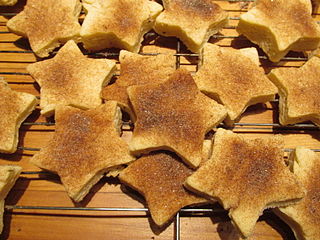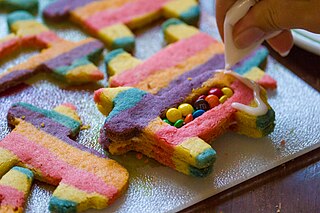 Russian tea cakes coated in confectioner's sugar | |
| Type | Pastry |
|---|---|
| Course | Dessert |
| Serving temperature | Hot or cold |
| Main ingredients | nuts, butter, powdered sugar |
Russian tea cake is a kind of pastry, often eaten around Christmas in the United States. [1]
 Russian tea cakes coated in confectioner's sugar | |
| Type | Pastry |
|---|---|
| Course | Dessert |
| Serving temperature | Hot or cold |
| Main ingredients | nuts, butter, powdered sugar |
Russian tea cake is a kind of pastry, often eaten around Christmas in the United States. [1]
Russian tea cakes have a relatively simple recipe, generally consisting entirely of flour, water, butter, and ground nuts, the nut variety depending upon the cookie type. After baking, they are rolled in powdered sugar while still hot, then coated again once the cookie has cooled. [2]
European recipes rely upon coarsely chopped hazelnuts, almonds, or walnuts. [3] Mexican wedding cookies traditionally use coarsely chopped pecans. [4]
A reason for the common name "Russian Tea Cake" or any connection to Russian cuisine is unknown. [1] Some have speculated the recipes either derived from other Eastern European shortbread cookies, may have migrated to Mexico with European nuns, or may have been associated with cookies served beside Russian samovars (tea urns). [1] By the 20th century, they were a part of wedding and Christmas and Easter traditions in the U.S., known by their popular "Russian tea cake" or "Mexican wedding cookie" name.

Dessert is a course that concludes a meal. The course consists of sweet foods, such as cake, biscuit, ice cream and possibly a beverage such as dessert wine and liqueur. Some cultures sweeten foods that are more commonly savory to create desserts. In some parts of the world there is no tradition of a dessert course to conclude a meal.

Cake is a flour confection made from flour, sugar, and other ingredients and is usually baked. In their oldest forms, cakes were modifications of bread, but cakes now cover a wide range of preparations that can be simple or elaborate and which share features with desserts such as pastries, meringues, custards, and pies.

Marzipan is a confection consisting primarily of sugar and almond meal, sometimes augmented with almond oil or extract.

Red velvet cake is traditionally a red, crimson, or scarlet-colored layer cake, layered with ermine icing. Traditional recipes do not use food coloring, with the red color possibly due to non-Dutched, anthocyanin-rich cocoa, and possibly due to the usage of brown sugar, formerly called red sugar.

Galette is a term used in French cuisine to designate various types of flat round or freeform crusty cakes, or, in the case of a Breton galette, a pancake made with buckwheat flour usually with a savoury filling. Of the cake type of galette, one notable variety is the galette des Rois eaten on the day of Epiphany. In French Canada the term galette is usually applied to pastries best described as large cookies.

The bizcochito or biscochito is a New Mexican crisp butter cookie made with lard, flavored with sugar, cinnamon, and anise. The dough is rolled thin and cut into the shape of the fleur-de-lis, the Christian cross, a star, or a circle, symbolizing the moon.
Queen Elizabeth cake is a lightly sweet, moist, and low-fat date cake, topped with a brown sugar, butter and broiled coconut mixture. "Queen Elizabeth cake" is named after the Queen of Canada, Elizabeth II, and may have first been made in 1953 for her coronation. Another account holds that it was invented for the 1937 coronation of King George VI and Queen Elizabeth, the Queen Mother. Despite its unsettled origin, the dessert gained national popularity in the 1950s and remains a Canadian staple.

An icebox cake is a dairy-based dessert made with cream, fruits, nuts, and wafers and set in the refrigerator. One particularly well-known version used to be printed on the back of boxes of thin and dark Nabisco Famous Chocolate Wafers.

Kichel is a slightly sweet cracker or cookie in Jewish cuisine. Made from eggs, flour, and sugar, the dough is rolled out flat and cut into bow-tie shapes.

Rainbow cookie or rainbow cake usually refers to a three-layered almond-flavored Italian-American cookie, but can also refer to any of a number of rainbow-colored confections.

Chocolate salami is an Italian and Portuguese dessert made from cocoa, broken biscuits, butter and sometimes alcohol such as port wine or rum. The dessert became popular across Europe and elsewhere, often losing alcohol as an ingredient along the way.

Sponge cake is a light cake made with eggs, flour and sugar, sometimes leavened with baking powder. Some sponge cakes do not contain egg yolks, like angel food cake, but most of them do. Sponge cakes, leavened with beaten eggs, originated during the Renaissance, possibly in Spain. The sponge cake is thought to be one of the first non-yeasted cakes, and the earliest attested sponge cake recipe in English is found in a book by the English poet Gervase Markham, The English Huswife, Containing the Inward and Outward Virtues Which Ought to Be in a Complete Woman (1615). Still, the cake was much more like a cracker: thin and crispy. Sponge cakes became the cake recognised today when bakers started using beaten eggs as a rising agent in the mid-18th century. The Victorian creation of baking powder by English food manufacturer Alfred Bird in 1843 allowed the addition of butter to the traditional sponge recipe, resulting in the creation of the Victoria sponge. Cakes are available in many flavours and have many recipes as well. Sponge cakes have become snack cakes via the Twinkie.

Sans rival is a Filipino dessert cake made of layers of buttercream, meringue and chopped cashews. Its name means "unrivaled" in French. The cake may be decorated, left plain or garnished with pistachios.

A piñata cookie is a sugar cookie that is shaped and colored like a piñata and filled with various small candies which spill out when the cookie is broken. Piñata cookies may be multicolored, which involves preparing separate batches of cookie dough and dyeing them different colors. The dough is then layered into a loaf with the various colors being separated A cookie cutter may be used to create various shapes. After the cookies are baked, they are further prepared by creating a hollow pocket, inside which the fillings are placed. They may be filled with candies, such as miniature M&Ms candy, chocolate buttons, or other ingredients. They are then sealed using frosting.
Sherry Yard is an American chef, restaurateur and cookbook author.

Claire Saffitz is an American food writer, chef, and YouTube personality. Until mid-2020, she was a contributing editor at Bon Appétit magazine and starred in several series on the Bon Appétit YouTube channel, including Gourmet Makes, in which she created gourmet versions of popular snack foods by reverse engineering them. Since leaving the company, she has published two cookbooks, Dessert Person and What's for Dessert, which both became New York Times Best Sellers. She has continued work as a video host on her own YouTube channel and as a freelance recipe developer, including for New York Times Cooking.